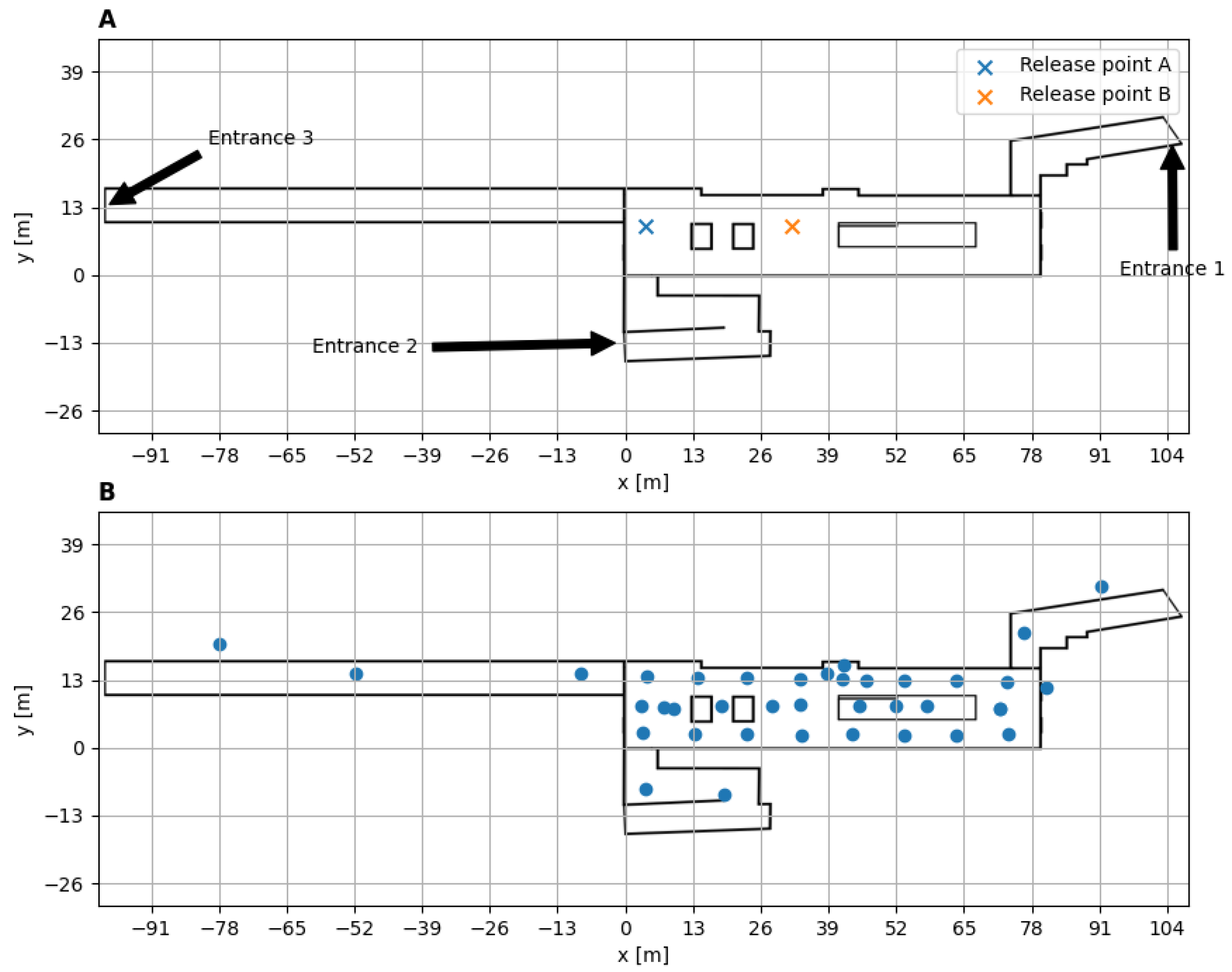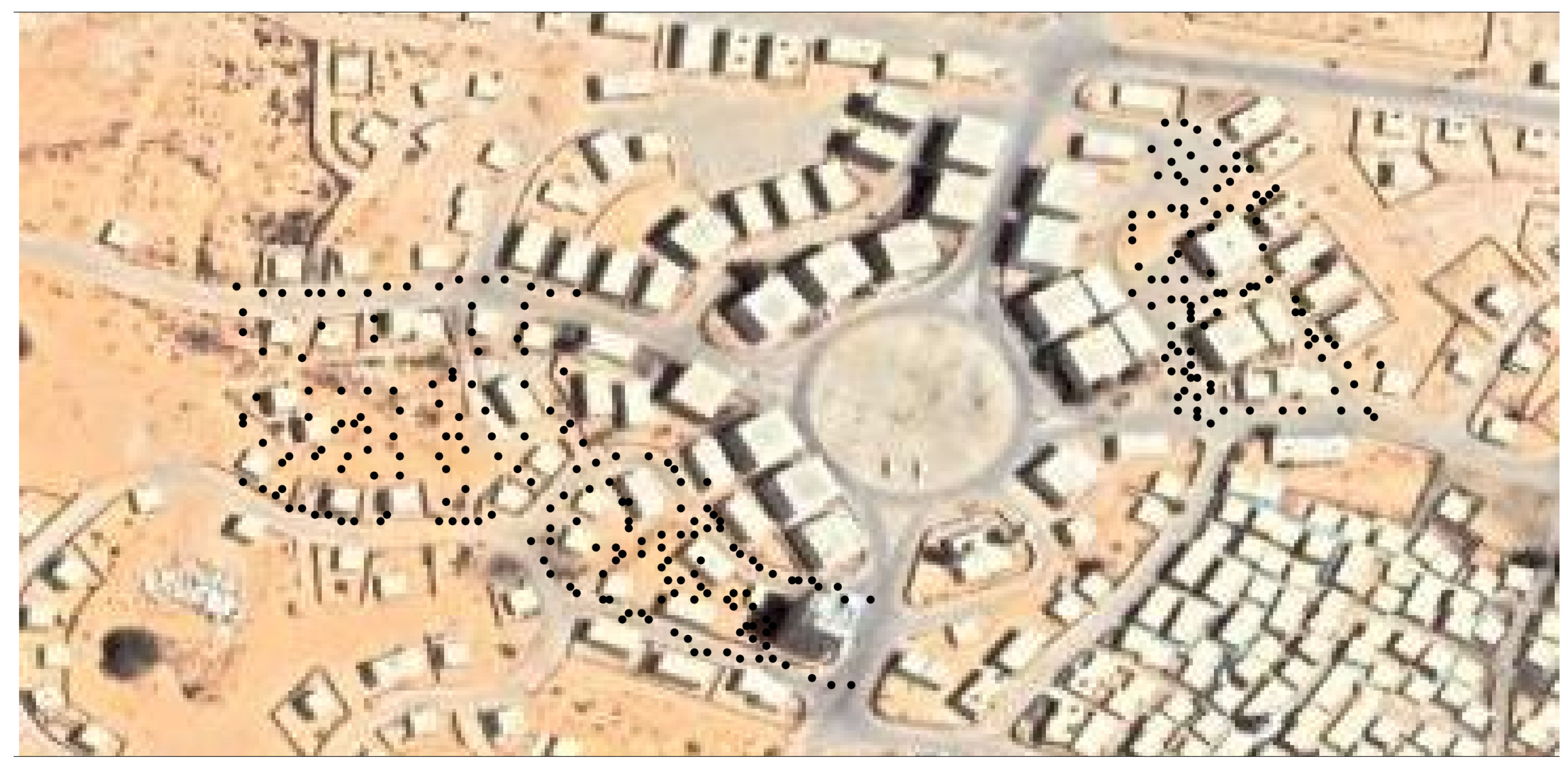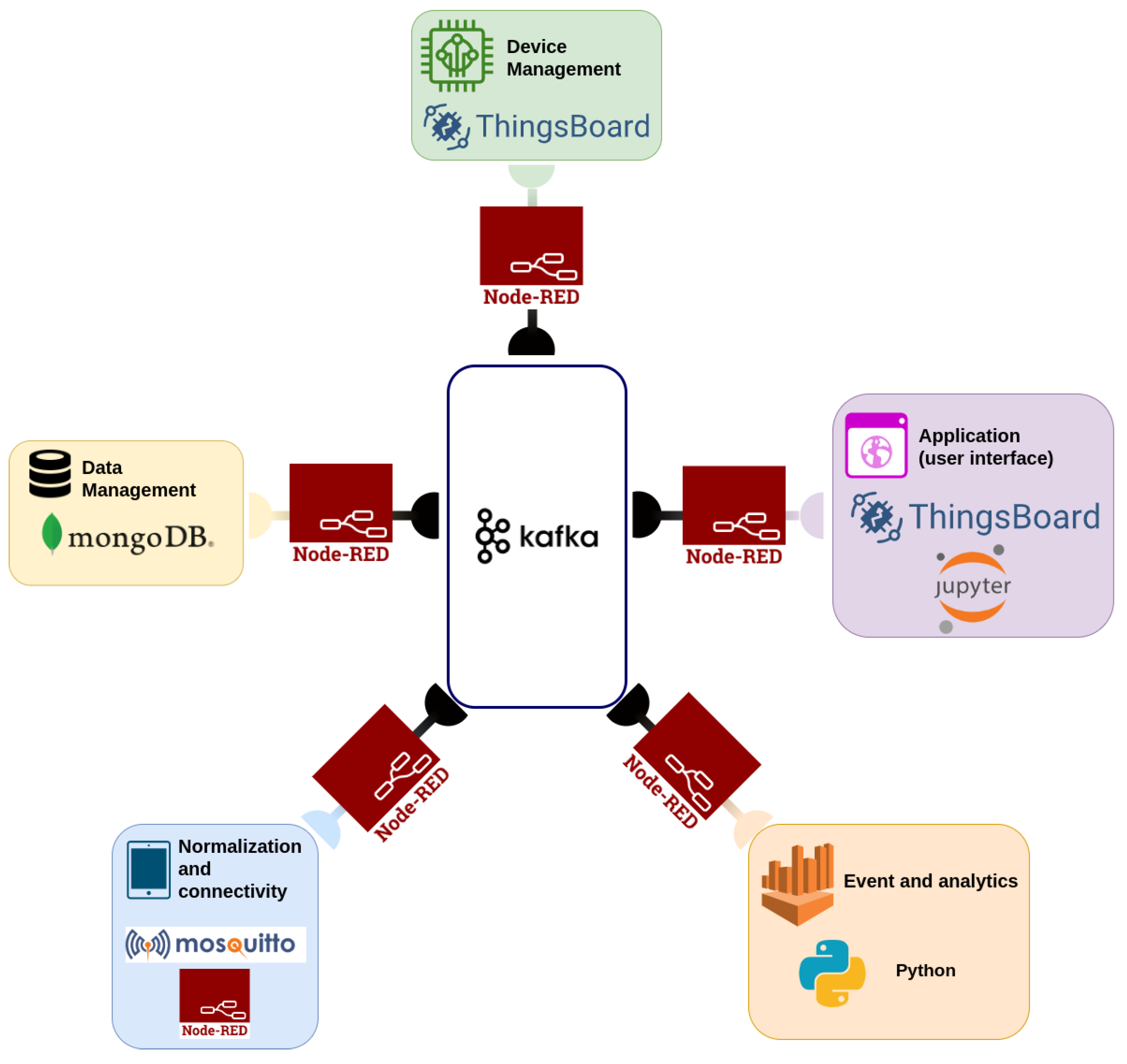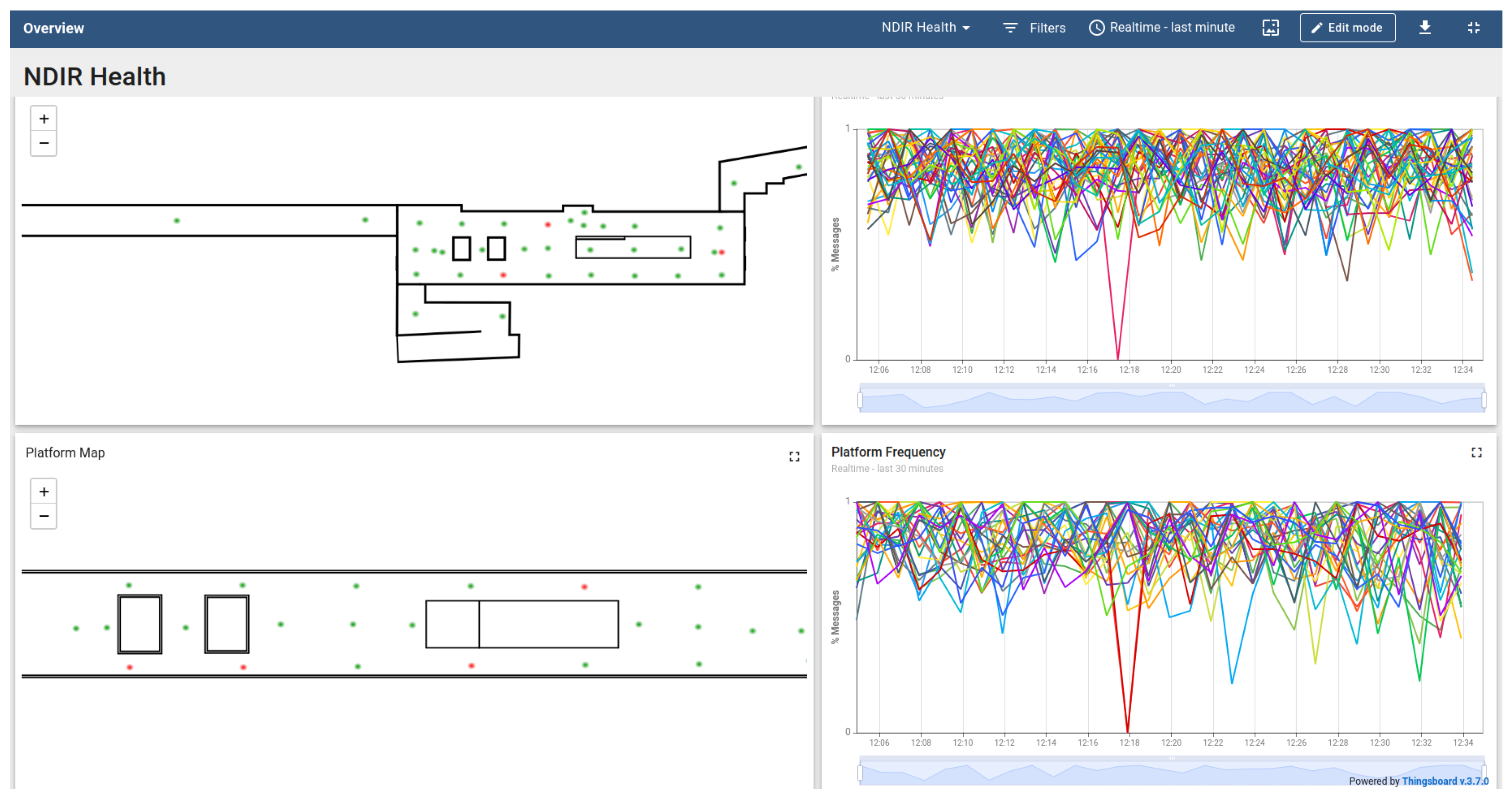An Industrial Internet-of-Things (IIoT) Open Architecture for Information and Decision Support Systems in Scientific Field Campaigns
Abstract
1. Introduction
- Each field campaign is unique and requires different methods of data collection and analysis. Therefore, the solution cannot provide well-defined and fixed dashboards for real-time monitoring and analysis. Instead, it must offer a tool that allows the technical team to customize it according to the specific requirements of the field campaign with minimal effort.
- The real-time monitoring of data is crucial only during the field campaign. After the field campaign concludes, it is essential to provide a user-friendly interface to access the collected data and the settings (e.g., details of the trials) under which they were gathered.
2. Example of Indoor and Outdoor Field Campaigns
2.1. Indoor Field Campaign
2.2. Outdoor Field Campaign
3. A Framework for an Information and Decision-Support System for Field Campaigns
3.1. Planning Module
3.2. Execution Module
3.2.1. The Architecture of the Server Domain
3.2.2. Implementation Using Open-Source Components
- The messaging layer is responsible for connecting the different microservices, and it is implemented with the Apache Kafka [68] and Node-RED [69] packages.Apache Kafka is a messaging service that delivers key–value messages to an arbitrary number of consumer processes [68], and as such, it constitutes the main backbone of the messaging system (Figure 7). One advantage of Apache Kafka is the fail-safe mechanism that handles failures in the server or in any consumer. To handle failures in the server, Kafka can be installed in a cluster, which prevents data losses in the case of a server failure [68]. To handle failures in the consumer, the server maintains a record of the messages that were successfully delivered, and it can fill in missing messages at later times. Another advantage of Apache Kafka is that its interface is implemented in many programming languages (more than 19 currently), and therefore, it simplifies the integration between different research teams that developed their codes in different programming languages.However, using the Apache Kafka interface requires integration with the code, which might require considerable effort or even be impossible for a commercial third-party code. To solve this problem, we use the Node-RED package [69] as an adaptor between the different components and the Apache Kafka messaging services (Figure 7).Node-RED [69] is a graphical flow-based programming tool for building extract–transform–load (ETL) applications. Each data item is represented as a message (a collection of key–values) that is transformed with each stage (node) of the workflow. The user connects nodes that perform a specific action to construct a workflow. Node-RED has a large repository of nodes that transform the content of the message, handle input and output, and determine the logic of the flow. In our framework, a designated workflow serves as the adaptor between Kafka messages and the specific protocols of the different components (see the normalization and connectivity layer below for an example). Since the programming of a workflow is done using a drag-and-drop interface for the different nodes, it is highly flexible and enables the user to adapt the workflow to specific needs with little effort. Node-RED has over 3000 nodes in its repository, and it is relatively simple to develop specialized nodes using the node-js programming language [69]. We note that Node-RED is generally used as middleware that connects the field and the server domains by regularizing the data collected from the different sensors [18]. In this work, Node-RED functions as middleware in that sense, but it also serves as a component that connects different components in the server domain (e.g., the application layer).
- A normalization and connectivity layer transforms the data into a standard format and is implemented using the Node-RED package [69]. The specific implementation of the normalization and connectivity layer depends on the protocols used by the devices in the field domain. For many communication protocols (such as TCP, UDP, CoAP, Modbus, CANBus, or reading from a file) it is sufficient to use only Node-RED, but some protocols require a specialized component. For example, the Mosquitto package [70] is required for the MQTT protocol, which is considered a standard for IoT ecosystems [71].In the field campaign presented in Section 2, the devices send the data in the UDP protocol using the format detailed in Section 2.1. The processing of each message is implemented as a Node-RED workflow (Figure 8). The ’UDP’ node (Figure 8, gray node) receives the message from the designated port in the UDP protocol. Then, the ’find device type’ node (Figure 8, light orange node) adds the device type to the message. The ’router’ node routes the message (Figure 8, yellow node) to the parsing nodes according to the device type (Figure 8, dark orange node). The message parsing consists of transforming it from a list of values separated with commas (the format in Section 2.1) to key–value pairs, where the key is the field’s name and the value is the actual data that was transmitted. Hence, the keys in each message after parsing depend on the type of device. Finally, the parsed message is transmitted to the Kafka messaging service (Figure 8, white node).
- The data management layer stores the data received from the normalization and connectivity layer. Since each device sends different information, we used MongoDB [72], a noSQL database that stores data as a key–value document, and therefore, it does not require any prior information on the structure of each message. We used a Node-RED workflow to store the Kafka data message sent via the normalization and connectivity layer as a record in MongoDB (Figure 7).
- The device management layer manages the state of the device. In this framework, we used the ThingsBoard package [73] to keep track of the device status. Thingsboard is an open-source IIoT platform that enables the rapid development, management, and scaling of IIoT applications. The package lets the user track the device’s state, build rules that trigger alarms, and design and present a real-time dashboard with the simple dragging and dropping of different graphical components (widgets). Thingsboard has a rich library of widgets for the presentation of pie charts, line charts, histograms, gauges, tables, control buttons, and map widgets. It is also possible to design and develop new widgets using Hypertext Markup Language version 5 (HTML5) and JavaScript.
- In the analytical layer, the data analysis is performed using dedicated routines that are usually programmed in Python or Java. Typical analysis routines receive a computational request via Kafka, query the data from MongoDB, perform a calculation, and send the result back. The computation request can be sent either from the GUI or periodically from a dedicated Node-RED workflow.
- Through the application (user interface), the research team can access the data acquired via the sensors and computed through the analytical layer via real-time dashboards or interactive workbooks.Real-time dashboards show the data online. As the analytical layer description mentioned, the ThingsBoard package [73] enables the user to build a dashboard using a simple drag-and-drop interface. The dashboard is published as a web page that can be accessed by other users.
4. The IIoT Application in the Indoor and Outdoor Field Campaigns
4.1. Indoor Field Campaign
4.2. Outdoor Field Campaign
5. Discussion
6. Conclusions
Author Contributions
Funding
Institutional Review Board Statement
Informed Consent Statement
Data Availability Statement
Acknowledgments
Conflicts of Interest
References
- Allwine, K.J.; Shinn, J.H.; Streit, G.E.; Clawson, K.L.; Brown, M. Overview of URBAN 2000: A multiscale field study of dispersion through an urban environment. Bull. Am. Meteorol. Soc. 2002, 83, 521–536. [Google Scholar] [CrossRef]
- Persson, P.O.G.; Fairall, C.W.; Andreas, E.L.; Guest, P.S.; Perovich, D.K. Measurements near the Atmospheric Surface Flux Group tower at SHEBA: Near-surface conditions and surface energy budget. J. Geophys. Res. Ocean. 2002, 107, SHE-21-1–SHE-21-35. [Google Scholar] [CrossRef]
- Higgins, W.; Ahijevych, D.; Amador, J.; Barros, A.; Berbery, E.H.; Caetano, E.; Carbone, R.; Ciesielski, P.; Cifelli, R.; Cortez-Vasquez, M.; et al. The NAME 2004 field campaign and modeling strategy. Bull. Am. Meteorol. Soc. 2006, 87, 79–94. [Google Scholar] [CrossRef]
- Doran, J.; Allwine, K.; Flaherty, J.; Clawson, K.; Carter, R. Characteristics of puff dispersion in an urban environment. Atmos. Environ. 2007, 41, 3440–3452. [Google Scholar] [CrossRef]
- Reynolds, R.M.; Sullivan, T.M.; Smith, S.; Cassella, V. The New York Midtown Dispersion Study (Mid-05) Meteorological Data; Report Number BNL-77945-2007-IR; Brookhaven National Laboratory: Upton, NY, USA, 2007.
- Martin, D.; Nickless, G.; Price, C.; Britter, R.; Neophytou, M.; Cheng, H.; Robins, A.; Dobre, A.; Belcher, S.E.; Barlow, J.F.; et al. Urban tracer dispersion experiment in London (DAPPLE) 2003: Field study and comparison with empirical prediction. Atmos. Sci. Lett. 2010, 11, 241–248. [Google Scholar] [CrossRef]
- Klausner, Z.; Ben-Efraim, M.; Arav, Y.; Tas, E.; Fattal, E. The Micrometeorology of the Haifa Bay Area and Mount Carmel during the summer. Atmosphere 2021, 12, 354. [Google Scholar] [CrossRef]
- Hickmon, H. Field Campaign Guidelines; Report Number DOE/SC-ARM-14-032; US Department of Energy: Washington, DC, USA, 2022.
- Hanna, S.R.; Brown, M.J.; Camelli, F.E.; Chan, S.T.; Coirier, W.J.; Hansen, O.R.; Huber, A.H.; Kim, S.; Reynolds, R.M. Detailed Simulations of Atmospheric Flow and Dispersion in Downtown Manhattan: An Application of Five Computational Fluid Dynamics Models. Bull. Am. Meteorol. Soc. 2006, 87, 1713. [Google Scholar] [CrossRef]
- Klausner, Z.; Kaplan, H.; Fattal, E. The Similar Days Method for Predicting Near Surface Wind Vectors. Meteorol. Appl. 2009, 16, 569–579. [Google Scholar] [CrossRef]
- Wilson, J.D.; Yee, E.; Ek, N.; d’Amours, R. Lagrangian simulation of wind transport in the urban environment. Q. J. R. Meteorol. Soc. 2009, 135, 1586. [Google Scholar] [CrossRef]
- Klausner, Z.; Fattal, E. An objective and automatic method for identification of pattern changes in wind direction time series. Int. J. Climatol. 2011, 31, 783–790. [Google Scholar] [CrossRef]
- Hanna, S.R.; White, J.; Trolier, J.; Vernot, R.; Brown, M.; Gowardhan, A.; Kaplan, H.; Alexander, Y.; Moussafir, J.; Wang, Y.; et al. Comparisons of JU2003 observations with four diagnostic urban wind flow and Lagrangian particle dispersion models. Atmos. Environ. 2011, 45, 4073–4081. [Google Scholar] [CrossRef]
- Li, X.; Yan, Y.; Shang, Y.; Tu, J. An Eulerian–Eulerian model for particulate matter transport in indoor spaces. Build. Environ. 2015, 86, 191–202. [Google Scholar] [CrossRef]
- Gavze, E.; Fattal, E. A Semi-analytical Model for Short-Range Near-Ground Continuous Dispersion. Bound.-Layer Meteorol. 2018, 169, 297–326. [Google Scholar] [CrossRef]
- Fattal, E.; David-Saroussi, H.; Klausner, Z.; Buchman, O. An Urban Lagrangian Stochastic Dispersion Model for Simulating Traffic Particulate-Matter Concentration Fields. Atmosphere 2021, 12, 580. [Google Scholar] [CrossRef]
- Fattal, E.; David-Saroussi, H.; Buchman, O.; Tas, E.; Klausner, Z. Heterogenous canopy in a Lagrangian-stochastic dispersion model for particulate matter from multiple sources over the Haifa bay area. Atmosphere 2023, 14, 144. [Google Scholar] [CrossRef]
- Abadía, J.J.P.; Walther, C.; Osman, A.; Smarsly, K. A systematic survey of Internet of Things frameworks for smart city applications. Sustain. Cities Soc. 2022, 83, 103949. [Google Scholar] [CrossRef]
- Kang, B.; Kim, D.; Choo, H. Internet of Everything: A Large-Scale Autonomic IoT Gateway. IEEE Trans.-Multi-Scale Comput. Syst. 2017, 3, 206–214. [Google Scholar] [CrossRef]
- Chen, H.; Jia, X.; Li, H. A brief introduction to iot gateway. IET Conf. Publ. 2012, 2011, 610–613. [Google Scholar] [CrossRef]
- Khanchuea, K.; Siripokarpirom, R. A Multi-Protocol IoT Gateway and WiFi/BLE Sensor Nodes for Smart Home and Building Automation: Design and Implementation. In Proceedings of the 10th International Conference on Information and Communication Technology for Embedded Systems, IC-ICTES 2019, Bangkok, Thailand, 25–26 March 2019; pp. 1–6. [Google Scholar] [CrossRef]
- Yacchirema, D.C.; Member, S. Smart IoT Gateway For Heterogeneous Devices Interoperability. IEEE Lat. Am. Trans. 2016, 14, 3900–3906. [Google Scholar] [CrossRef]
- Ali, O.; Ishak, M.K.; Bhatti, M.K.L.; Khan, I.; Kim, K.I. A Comprehensive Review of Internet of Things: Technology Stack, Middlewares, and Fog/Edge Computing Interface. Sensors 2022, 22, 995. [Google Scholar] [CrossRef]
- Latif, S.; Driss, M.; Boulila, W.; Huma, Z.E.; Jamal, S.S.; Idrees, Z.; Ahmad, J. Deep Learning for the Industrial Internet of Things (IIoT): A Comprehensive Survey of Techniques, Implementation Frameworks, Potential Applications, and Future Directions. Sensors 2021, 21, 7518. [Google Scholar] [CrossRef] [PubMed]
- Paniagua, C.; Delsing, J. Industrial Frameworks for Internet of Things: A Survey. IEEE Syst. J. 2021, 15, 1149–1159. [Google Scholar] [CrossRef]
- Abuhasel, K.A.; Khan, M.A. A Secure Industrial Internet of Things (IIoT) Framework for Resource Management in Smart Manufacturing. IEEE Access 2020, 8, 117354–117364. [Google Scholar] [CrossRef]
- Microsoft Azure IoT. 2024. Available online: https://azure.microsoft.com/en-us/solutions/iot (accessed on 26 August 2024).
- Amazon Web Services (AWS) IoT. 2024. Available online: https://aws.amazon.com/iot/ (accessed on 26 August 2024).
- Google Cloud IoT. 2024. Available online: https://cloud.google.com/iot-core (accessed on 26 August 2024).
- IBM Watson IoT. 2024. Available online: https://internetofthings.ibmcloud.com/ (accessed on 26 August 2024).
- Siemens MindSphere. 2024. Available online: https://www.siemens.com/global/en/products/automation/topic-areas/it-ot-convergence/siemens-iiot.html (accessed on 26 August 2024).
- General Electric. GE Digital Predix. 2024. Available online: https://www.ge.com/digital/blog/what-industrial-internet-things-iiot (accessed on 26 August 2024).
- PTC ThingWorx. 2024. Available online: https://www.ptc.com/en/products/thingworx (accessed on 26 August 2024).
- Bosch IoT Suite. 2024. Available online: https://bosch-iot-suite.com/ (accessed on 26 August 2024).
- SAP Leonardo IoT. 2024. Available online: https://help.sap.com/docs/SAP_CP_IOT_CF?locale=en-US (accessed on 26 August 2024).
- Honeywell Forge. 2024. Available online: https://process.honeywell.com/us/en/products/field-instruments/honeywell-versatilis-iot-sensor-solutions (accessed on 26 August 2024).
- Eclipse Foundation. Eclipse Kura. 2024. Available online: https://eclipse.dev/kura/ (accessed on 26 August 2024).
- Open Connectivity Foundation. IoTivity. 2024. Available online: https://iotivity.org/ (accessed on 26 August 2024).
- OpenHAV Foundation. OpenHAB. 2024. Available online: https://openhabfoundation.org/ (accessed on 26 August 2024).
- Edge Foundation. EdgeX Foundry. 2024. Available online: https://www.edgexfoundry.org/ (accessed on 26 August 2024).
- OpenIoT Project. 2024. Available online: https://openiot.fbk.eu/ (accessed on 26 August 2024).
- Apache Software Foundation. Apache Edgent. 2024. Available online: https://incubator.apache.org/projects/edgent.html (accessed on 26 August 2024).
- Eclipse Ditto. 2024. Available online: https://eclipse.dev/ditto/ (accessed on 26 August 2024).
- Ahmad, M.I.; Yusof, Y.; Mustapa, M.S.; Daud, M.E.; Latif, K.; Kadir, A.Z.A.; Saif, Y.; Adam, A.; Hatem, N. A novel integration between service-oriented IoT-based monitoring with open architecture of CNC system monitoring. Int. J. Adv. Manuf. Technol. 2024, 131, 5625–5636. [Google Scholar] [CrossRef]
- Folgado, F.J.; González, I.; Calderón, A.J. Data acquisition and monitoring system framed in Industrial Internet of Things for PEM hydrogen generators. Internet Things 2023, 22, 100795. [Google Scholar] [CrossRef]
- Bua, C.; Adami, D.; Giordano, S. GymHydro: An Innovative Modular Small-Scale Smart Agriculture System for Hydroponic Greenhouses. Electronics 2024, 13, 1366. [Google Scholar] [CrossRef]
- Gahalyan, S.; Sriramalakshmi, P. IoT based smart ferry system. J. Phys. Conf. Ser. 2021, 2115, 12015. [Google Scholar] [CrossRef]
- USEPA. Meteorological Monitoring Guidance for Regulatory Modeling Applications; Epa-454/R-99-005; USEPA: Research Triangle Park, NC, USA, 2000; p. 171.
- Trnka, D. Policies, Regulatory Framework and Enforcement for Air Quality Management: The Case of Korea; Technical Report 158; Organisation for Economic Co-operation and Development (OECD): Paris, France, 2020. [Google Scholar] [CrossRef]
- Strategies for Mitigating Air Pollution in Mexico City. In Proceedings of the International Transport Forum, Leipzig, Germany, 31 May–1 June 2017.
- Smartgas. SF6 Sensor. 2024. Available online: https://www.smartgas.eu/en/gases/sf6-sensor (accessed on 31 August 2024).
- Elcon. SMART Pt-100 TRANSMITTER. 2024. Available online: https://www.elcon.co.il/wp-content/uploads/2017/05/e-con-catalog.pdf (accessed on 3 September 2024).
- Kaijo. Ultrasonic Anemometer. 2024. Available online: https://u-sonic.co.jp/product/category/detail/sid:19565c8c-cd95-11e9-b11b-9ca3ba0232db/pid:a630b514-050a-11ea-bcc9-ae9f117a2f7b (accessed on 3 September 2024).
- Campbell Scientific CR1000X Datalogger. 2024. Available online: https://www.campbellsci.com/cr1000x (accessed on 3 September 2024).
- Kurose, J.F.; Nyu, K.W.R.; Shanghai, N.; Columbus, B.; New, I.; San, Y.; Hoboken, F.; Cape, A.; Dubai, T.; Madrid, L.; et al. Computer Networking: A Top-Down Approach, 7th ed.; Pearson: Hoboken, NJ, USA, 2017; p. 852. [Google Scholar]
- R. M. Young Company, Michigan Young 3-Axis Ultrasonic Anemometer Model 81000. 2024. Available online: https://s.campbellsci.com/documents/ca/manuals/81000_man.pdf (accessed on 3 September 2024).
- Rotronic, Process Sensing Technologie, UK HC2A-S3 Probe. 2024. Available online: https://www.rotronic.com/pub/media/productattachments/files/12.1085.0103_HygroClip2_Advanced_web.pdf (accessed on 3 September 2024).
- Kipp & Zonnen CNR1. 2024. Available online: https://www.kippzonen.com/Download/85/Manual-CNR-1-Net-Radiometer-English (accessed on 3 September 2024).
- Sierra Wireless AirLink LS300. 2024. Available online: https://source.sierrawireless.com/resources/airlink/hardware_reference_docs/airlink-ls300---user-guide/# (accessed on 3 September 2024).
- ArgosWeb. 2024. Available online: https://github.com/KaplanOpenSource/argos (accessed on 3 September 2024).
- Argos. 2024. Available online: https://github.com/argosp/pyargos (accessed on 3 September 2024).
- Pandas Development Team. Pandas-dev/Pandas: Pandas. Version 1.0.3. 2020. Available online: https://pandas.pydata.org (accessed on 3 September 2024).
- Gupta, P. Three Software Stacks for IoT Solutions. 2017. Available online: https://mobilestack.com/blog/three-software-stacks-for-iot-solutions/ (accessed on 3 September 2024).
- Eclipse IoT Working Group. The Three Software Stacks Required for IoT Architectures. IoT Archit. 2016, 2016, 17. [Google Scholar]
- St. Laurent, A.M. Understanding Open Source and Free Software Licensing; O’Reilly: Sebastopol, CA, USA, 2004; p. 193. [Google Scholar]
- Waters, M.; Waszczuk, P.; Ayre, R.; Dreze, A.; McGlinchey, D.; Alkali, B.; Morison, G. Open Source IIoT Solution for Gas Waste Monitoring in Smart Factory. Sensors 2022, 22, 2972. [Google Scholar] [CrossRef]
- Newman, S. Building Microservices; O’Riley: Sebastopol, CA, USA, 2015; p. 280. [Google Scholar]
- Walkenbach, J. Kafka the Definitive Guide. arXiv 2010, arXiv:1011.1669v3. [Google Scholar]
- Node-RED. 2024. Available online: https://nodered.org/ (accessed on 3 September 2024).
- Mosquitto. 2024. Available online: https://github.com/eclipse/mosquitto (accessed on 3 September 2024).
- Zhao, Q. Presents the Technology, Protocols, and New Innovations in Industrial Internet of Things (IIoT). In Internet of Things for Industry 4.0: Design, Challenged and Solutions; EAI/Springer Innovations in Communication and Computing; Springer: Cham, Switzerland, 2020; pp. 39–56. [Google Scholar] [CrossRef]
- MongoDB. MongoDB: The Developer Data Platform. 2024. Available online: https://www.mongodb.com/ (accessed on 3 September 2024).
- Thingsboard. 2024. Available online: https://thingsboard.io/ (accessed on 3 September 2024).
- Jupyter. 2024. Available online: https://jupyter.org/ (accessed on 3 September 2024).
- Skamarock, W.C.; Klemp, J.B.; Dudhia, J.; Gill, D.O.; Barker, D.M.; Duda, M.G.; Huang, X.Y.; Wang, W.; Powers, J.G. A Description of the Advanced Research WRF Version 3; National Center for Atmospheric Research: Boulder, CO, USA, 2008. [Google Scholar]











| Name | Start | End | Release Point | Amount Released (g) | Release Time | Entrance Doors |
|---|---|---|---|---|---|---|
| A1 | 7-3-2022 9:10 | 3-7-2022 9:39 | A | 500 | 3-7-2022 9:19 | open |
| A2 | 7-3-2022 11:00 | 3-7-2022 11:40 | A | 500 | 7-3-2022 11:10 | open |
| A3 | 7-3-2022 11:40 | 3-7-2022 12:10 | A | 500 | 7-3-2022 11:44 | closed |
| A4 | 7-3-2022 14:15 | 3-7-2022 14:56 | A | 500 | 7-3-2022 14:26 | closed |
| B1 | 7-3-2022 09:20 | 3-8-2022 09:50 | B | 500 | 7-3-2022 09:30 | open |
| B2 | 7-3-2022 10:30 | 3-8-2022 10:55 | B | 500 | 7-3-2022 10:35 | open |
| B3 | 7-3-2022 12:15 | 3-8-2022 12:49 | B | 500 | 7-3-2022 12:19 | closed |
| B4 | 8-3-2022 14:15 | 3-8-2022 14:52 | B | 500 | 8-3-2022 14:22 | closed |
Disclaimer/Publisher’s Note: The statements, opinions and data contained in all publications are solely those of the individual author(s) and contributor(s) and not of MDPI and/or the editor(s). MDPI and/or the editor(s) disclaim responsibility for any injury to people or property resulting from any ideas, methods, instructions or products referred to in the content. |
© 2024 by the authors. Licensee MDPI, Basel, Switzerland. This article is an open access article distributed under the terms and conditions of the Creative Commons Attribution (CC BY) license (https://creativecommons.org/licenses/by/4.0/).
Share and Cite
Arav, Y.; Klausner, Z.; David-Sarrousi, H.; Eidelheit, G.; Fattal, E. An Industrial Internet-of-Things (IIoT) Open Architecture for Information and Decision Support Systems in Scientific Field Campaigns. Sensors 2024, 24, 5916. https://doi.org/10.3390/s24185916
Arav Y, Klausner Z, David-Sarrousi H, Eidelheit G, Fattal E. An Industrial Internet-of-Things (IIoT) Open Architecture for Information and Decision Support Systems in Scientific Field Campaigns. Sensors. 2024; 24(18):5916. https://doi.org/10.3390/s24185916
Chicago/Turabian StyleArav, Yehuda, Ziv Klausner, Hadas David-Sarrousi, Gadi Eidelheit, and Eyal Fattal. 2024. "An Industrial Internet-of-Things (IIoT) Open Architecture for Information and Decision Support Systems in Scientific Field Campaigns" Sensors 24, no. 18: 5916. https://doi.org/10.3390/s24185916
APA StyleArav, Y., Klausner, Z., David-Sarrousi, H., Eidelheit, G., & Fattal, E. (2024). An Industrial Internet-of-Things (IIoT) Open Architecture for Information and Decision Support Systems in Scientific Field Campaigns. Sensors, 24(18), 5916. https://doi.org/10.3390/s24185916





